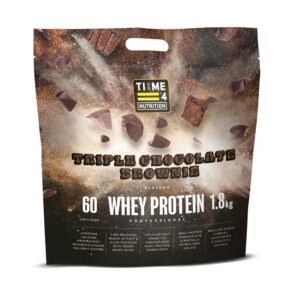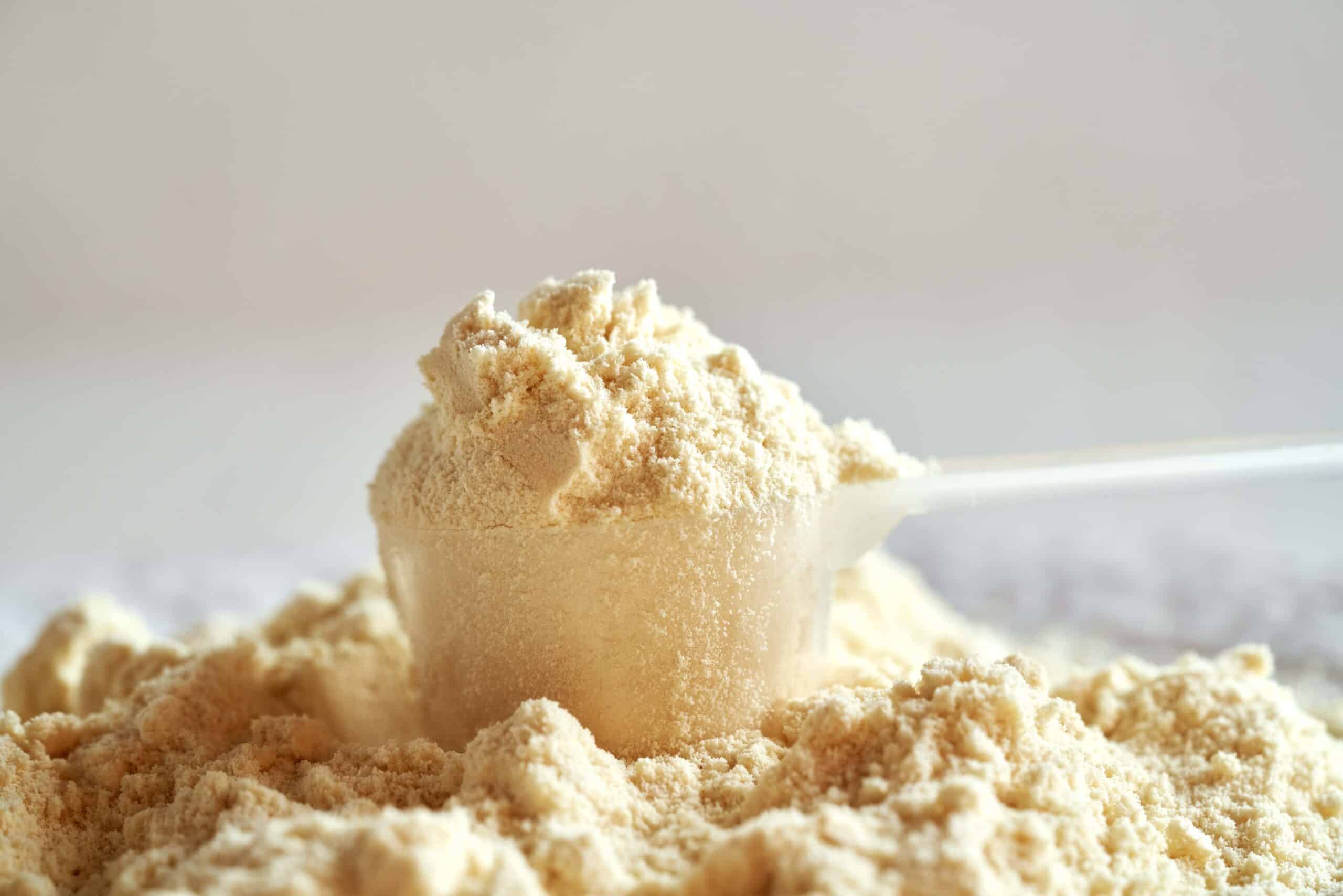The Benefits Of Undenatured Protein Powder
What do we mean when we describe a dairy protein as denatured?
The Benefits Of Undenatured Protein Powder
By Brian Batcheldor
In this article, we are going to have a recap on how the impact of various processing techniques impact the end product and why this really matters to the protein supplement consumer. Hopefully, along the way, we are also going to dispel some of the myths that are being fed to you by supplement and dairy companies.
Today, the big word in protein supplement technology is undenatured. This means that the protein has not been subjected to treatment that has resulted in conformational, structural changes. So exactly what kind of treatment results in this type of damage? In simple terms, any process that involves pH changes and/or heat pasteurization.
Over several past articles on whey, we have looked at the amazing immuno-supportive and growth promotional properties of whey’s bioactive fractions. Now would be a good time to look at what damages these fractions and how this relates to the processing methods that most material used in sports nutrition goes through.
| FRACTION | DAMAGED BY |
|---|---|
| Beta-Lacto globulin | Reasonably stable. |
| Alpha-Lactalbumin | Partially denatured by acid pH conditions |
| Glycomacropeptides | Adjustment of pH. |
| Immunoglobulins | Acid pH and heat, destroyed at 60 degrees C |
| Bovine Serum Albumin | Heat treatment, damaged at 72.22 Degrees C. |
| Growth factors | Any processing, as they are contained in the fat globule membrane. |

The Benefits Of Undenatured Protein Powder: The issue of oral bioavailability
Whilst there may be some degree of species specificity with milk fractions, we absolutely know that they have both bioavailability and bioactivity in humans to varying degrees when processed correctly. Denaturation is a more significant factor for affecting absorption. Bioavailability of bovine milk fractions has been demonstrated in many studies with various animals, after all, – they were meant to be orally ingested.
The Benefits Of Undenatured Protein Powder: Amino Acids denaturation
Adjustment of pH and heat treatment (pasteurization) is also known to denature some amino acids, in particular, cysteine and methionine. If we refer back to the various protein rating systems covered in past articles by myself, the common denominator with the top scoring proteins is cysteine. As well as being a precursor to the powerful antioxidant, glutathione, cysteine is believed to be a regulator of nitrogen balance and body cell mass. It has also been noted that in various catabolic conditions, the cysteine-mediated regulatory circuit is compromised, further underlining the key role that this amino acid plays (1).
Whey protein supplements will utilize material that has been produced by one or sometimes both of the following processing techniques.
- Filtration
- Ionic exchange
Let us now look at what is involved in these techniques, so that we may determine what is lost or damaged by each process.
The Benefits Of Undenatured Protein Powder: Ionic exchange
This process involves separating proteins based on their electrical charge. Hydrochloric acid and sodium hydroxide are the chemical reagents normally used to achieve this. The electrical charge on the proteins attaches them to resins in the reaction vessel. Obviously, these reagents damage pH sensitive fractions and denature some amino acids. Going back to our table above, it becomes clear that we can say goodbye to glycomacropeptides, the immunoglobulins, lactoferrin, the growth factors and a big percentage of the alpha-lactalbumin content. Cysteine and methionine will also be denatured (lost). If some fractions have been eliminated or reduced, then the resultant shift in the balance will mean that other fractions now represent a higher percentage of the material. Beta-lactoglobulin, a reasonably stable fraction, can account for up to 75% of the fractions present in ion exchange material. Is there a problem with this? As I have pointed out in a previous article, beta-lactoglobulin can cause allergic reactions in some individuals.
Another damaging factor with this type of processing is that it is known to form lysinoalanine, -an anti-nutritional bonded amino acid compound that results in losses of the following amino acids:
- Cysteine (73-77%)
- Threonine (35-45%)
- Serine (18-30%)
- Lysine (19-20%)
High amounts of lysinoalanine can often be found in ion exchange whey and may produce adverse effects on growth, protein digestibility, protein quality and mineral bioavailability and digestibility (2).
The Benefits Of Undenatured Protein Powder: Lysinoalanine
So why did this material ever become popular? Heavy marketing from the dairy companies is the answer here, but then you have to ask yourself why they developed it in the first place. This was mainly political. Before ion exchange came along, ultrafiltration was the only practical alternative in operation. However, a French patent on this process meant that all companies had to pay to use it. This expensive inconvenience resulted in the big companies looking for other alternatives. When the ion exchange process was developed, it provided these companies with a lot more freedom. Even when microfiltration came along, the ion exchange process still retained its popularity, as the set-up cost is around one fifth that of microfiltration. So you see, the development of ion exchange whey had little to do with any benefit to the consumer. Long after several nutrition companies became aware of the disadvantages of ion exchange whey, the big dairy companies kept on promoting it, as they were now sat on a mountain of this material. Eventually, even they realized that they were just “peeing against the wind.”
The marketing ploys that were used to promote ion exchange whey centered around it being higher in protein and lower in fat and lactose than ultrafiltrated material. High levels of BCAAs were also regularly mentioned in advertising campaigns. All of these points are true, but we know, of course, that we need to be concerned with the other more important factors found in dairy proteins.
The biggest boost to sales of ion exchange whey into the sports nutrition industry came about through a combination of ignorance and very devious marketing. This gave birth to the biggest marketing sting ever to hit the industry. Most of us remember which was the first meal replacement product (MRP) to hit the market and this used filtrated materials in its formula. Both the supplier of those materials and the inventor of the product knew that this was central to any effectiveness. However, the inventor of this product later dissolved his business partnership and felt secure in the knowledge that the patent on his product protected it. When ion exchange whey came along, it offered his ex-partner the opportunity to use a material made by a process sufficiently different to not violate the patent. Whether the partner completely missed the point with the original product or just plain didn’t care, I can’t tell you. What I can tell you is that the ex-partner owned the most hardcore bodybuilding magazine of that era (the title of which wouldn’t have made sense after the year 2000!), their very open format, which left no stone unturned, was then used as the ideal vehicle to promote the new product. He then teamed up with another of the industry’s “big-wigs” to promote the ion exchange whey found in both of their products, deceiving the public into thinking that this was an entirely unrelated venture. This double-barrelled assault on the market was, without a doubt, the most influential campaign ever put together. Personally, I feel that they have closed the door behind them and that no company will ever get away with this scam again.

The Benefits Of Undenatured Protein Powder
Filtration
Whey Protein Concentrates (WPCs) are materials with a protein percentage typically ranging from the high seventies up to as much as 82 percent. Once we go over this figure, we are talking about Whey Protein Isolates (WPIs), which are produced by ion exchange, microfiltration or, as I mentioned earlier, a combination of both. Microfiltration is a process that uses much finer filter membranes and removes far more fat and lactose. OK, -so now we know that ion exchange material is not the “whey to go”. This must surely mean that there is only one real alternative, right? Now the plot really thickens! Remember that ultrafiltrated material is higher in fat, thus concentrates, which are produced by this process, are more likely to have growth factors present. Even without any heat or pH adjustment, the growth factors will not be retained to any significant degree in microfiltrated material. Cross Flow Microfiltration is flavour of the month at the moment. This is generally described as a natural, low temperature process that employs high-tech ceramic filters that filter out fat, lactose, cholesterol and denatured proteins. The big dairy companies that specialize in this material will also tell you that it has the highest levels of undenatured protein possible, the high solubility of the material serving as evidence of how undenatured it is. Well, I’m sorry, but I’m going to have to burst another bubble here!
Some dairy companies are misleading the consumer by equating solubility with levels of denaturation, when it is quite simply only a milk QA test. One can test the degree of damage that heat has done to whey proteins by determining their centrifuged water solubility. This test does not determine denaturation from any other conditions (like pH changes); it only determines heat damage. Neither was it ever intended as a denaturation test, -it is a heat damage test only! If a whey protein has been completely destroyed by heat exposure (not just a structural denaturing change, but absolutely destroyed), it coagulates and will settle out as sediment when the whey is centrifuged. The higher the level of centrifuged sediment, the higher degree of heat destruction. The test result is expressed as a percent of the total whey protein present. This test was developed to be run on milk powders to determine the degree of heat damage and was never intended to be run on whey protein concentrates/isolates. In milk powders, a low heat milk powder will have a result of 1% or less (when the milk powder only contains about 6% whey protein in total … so a low heat damaged milk powder has up to 16% of the whey protein destroyed). A medium heat milk powder has a result of 1%-3% … meaning that up to 50% of the whey proteins can be destroyed by heat and still the damage is considered only medium. To show you how slippery things can get, the whey protein processors run this test on their whey protein and show that their final product whey protein powder is 99% soluble in water, and therefore, is not denatured (?). What they do not tell anybody is that they have already processed out all the denatured whey protein before they concentrate down the remaining undamaged protein. You see, heat damaged whey protein just plugs ultrafiltration, microfiltration and nanofiltration membranes causing the processor all sorts of problems. A long time ago, they found out that filtration ran easier if they first centrifuged the whey to remove all of the heat and pH damaged whey proteins. They then only concentrate down the non-heat destroyed part of the protein. That does not mean that they have concentrated down all the protein fractions … they have only concentrated the most heat stable parts. When they finish processing, they can show that the final product has little evidence of heat damage (because they already removed the heat damaged parts). This is why all of these fools claim that their whey protein is “un-denatured”. That is not a correct statement! The correct statement should read, “The whey protein powder that we are selling exhibits low denaturation because the denatured whey proteins were removed during processing”. The best fractions of whey protein have been destroyed by the required pasteurization and removed during processing! That is why most of the whey proteins commercially available do not contain the levels of the bioactive protein fractions that the textbooks list. Yet, almost all of them can show 99% water solubility. Let’s get this straight, water solubility does not equate to denaturation! Water solubility only shows that the process did a decent job of removing the denatured whey proteins during processing. What the consumer gets from the “un-denatured” whey proteins from cheese and casein is not even strictly a whey protein. In order to be a whey protein, all of the protein fractions have to be represented in the ratios and amounts that would be expected in unprocessed milk. Such is not the case with the whey proteins coming out of the cheese and casein factories. The best fractions are gone or significantly destroyed and removed.
Below, I have compared the fraction content of a market average whey protein concentrate (WPC) with a whey protein isolate (WPI). This demonstrates that, despite what the dairy companies tell us, filtration techniques still reduce fraction content in that step from concentrate to isolate.
| Average WPC | Average WPI |
|---|---|
| Alpha-Lactalbumin 11.3% – 14.5% | 8.3% – 22.6% |
| Beta-Lactoglobulin 37.9% – 49.0% | 38.9% – 73.0% |
| IgG Heavy 5.0% – 7.9% | 1.0% – 3.5% |
| BSA 1.1% – 3.0% | 0.0% – 1.8% |
| Lactoferrin 1.3% – 1.8% | 0.0% – 1.8% |
| GMPs 0.0% – 11.0% | 0.0% – 1.0% |
GMPs are not to be found in the highest concentrations in whey protein, they are found most abundantly in undenatured micellar casein, always remember that this is a distinctly different material from regular caseinate, which contains no GMPs. Undenatured casein also contains casomorphin peptides which slow down gastric emptying by binding to opiate receptors. This helps keep the excitatory hormone CKK, stimulated by GMP ingestion, in check and improves net protein utilization. This serves to illustrate the fine balance nature has achieved with maternal milk protein ratios.
Based on this information, it becomes obvious that the best source for fractions would be a combined (skimmed) milk protein product i.e. one that contained undenatured casein and whey in different forms (e.g. WPC, WPI and WPH). This falls in line with the philosophy of combining “fast” and “slow” dietary proteins for optimum benefit.
Introducing Time 4 Whey Protein Professional
Time 4 Whey Protein Professional sets the standard for a new era of evidence-based sports supplements.
Our Premium Grass Fed Timed Release Peptide Protein Blend contains Whey Protein Concentrate, Partially Hydrolysed Whey Isolate & Micellar Casein protein in their undenatured form & NO cheap fillers such as skimmed milk powder.
We have also added additional Leucine & Taurine for enhanced muscle growth & exercise performance, Glycyl-L-Leucine to maximise the uptake of Leucine, Lactoferrin to enhance recovery & immunity, plus Digestive Enzymes to optimise absorption.
Time 4 Whey Protein Professional does not contain carboxymethylcellulose (CMC) is suitable for Vegetarians & is Gluten & Soy Free.

The Benefits Of Undenatured Protein Powder
Appendix; Fractions and their functions
-
- Lactoferrin: I have placed this at the top of the list as it probably the most important fraction of all. Biotechnology companies are doing a lot of work with this particular fraction at the moment, its post-operative tissue regeneration and antibacterial properties being of particular interest. Known to promote healthy GI function (3), it is also a potentially effective antioxidant. Lactoferrin has been shown in numerous studies to stimulate the immune defense system (2), to alter the effects of immune modulators and to very effectively bind and transport iron (4). Pharmaceutical preparations containing this material are currently being explored.
- Proteose-Peptone: High in glycomacropeptides (GMPs), the percentage content of which has become a major marketing tool for some whey protein formulas.
GMPs contain virtually all the sialic acid found in milk, a substance known to eliminate viruses from the system by binding to them. Including whey proteins in the diet that are high in sialic acid has been demonstrated to reduce the chances of catching influenza (5). They are also known to promote the growth of friendly bacteria (probiotics) in the large intestine (6) and to aid passage and absorption of some bioactive fractions (7). GMPs can also affect modulation of digestion via the release of the hormone cholecystokinin (CKK) after protein or fat ingestion (8). - Immunoglobulins (IgG): Their role is support of the immune system and they are perhaps the most specific fraction to human immune function.
- Bovine Serum Albumin (BSA): A glutathione precursor, BSA has powerful antioxidant and tumor prevention properties.
- Growth Factors: Contained within the fat globule membrane, they are believed to promote growth and result in elevation of plasma IGF.
- Alpha-Lactalbumin: The most abundant fraction in human milk, many believe this to be the most nutritive and easily digestible fraction for humans. Unfortunately, it is usually low in most bovine dairy products.
- Beta-Lactoglobulin: The most abundant fraction in bovine milk, it is not found in human milk at all. Allergic reactions to it are common, the reason why the infant formula market is trying to find an alpha-lactalbumin predominant formula. Marketed as being high in BCAAs, yet it has no advantage over alpha-lactalbumin here.
- Lactoperoxidase: Once again, another immuno-supportive fraction.

